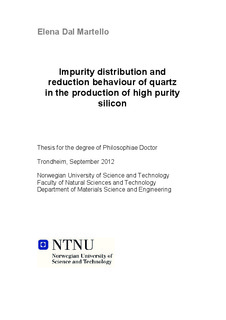| dc.contributor.author | Dal Martello, Elena | nb_NO |
| dc.date.accessioned | 2014-12-19T13:26:18Z | |
| dc.date.available | 2014-12-19T13:26:18Z | |
| dc.date.created | 2012-09-12 | nb_NO |
| dc.date.issued | 2012 | nb_NO |
| dc.identifier | 551977 | nb_NO |
| dc.identifier.isbn | 978-82-471-3658-4 (printed version) | nb_NO |
| dc.identifier.isbn | 978-82-471-3659-1 (electronic version) | nb_NO |
| dc.identifier.uri | http://hdl.handle.net/11250/249045 | |
| dc.description.abstract | The production of solar grade silicon is based on the use of expensive high purity carbon and quartz feedstock as well as various silicon refining techniques. Impurities in the feedstock materials enter the silicon during the carbothermic reduction of quartz. The knowledge of the impurity distribution/removal in the feedstock and in the carbothermic reduction process is necessary for targeting less pure and cheaper raw materials.
The aim of the present study is to investigate the impurity distribution and behavior in quartz feedstock throughout the metallurgical production of silicon; in particular four areas were investigated: 1) removal of mineral inclusions from quartz prior to carbothermic reduction by means of selective fragmentation; 2) effect of pellets, lumps on the silicon production reactions; 3) high temperature properties of quartz under reducing conditions; 4) distribution of contaminants from quartz to the gas phase during quartz reduction. Pellets and lumpy charge, hydrothermal quartz and quartzite were studied.
Because of the complex objective of this study, several experimental techniques as well as characterization methods were used: 1) a novel refining route for hydrothermal quartz based on electrical fragmentation, was tested in a laboratory scale to investigate the advantages of using electric fragmentation in terms of cracks distribution, mineral liberation and fragment morphology; 2) mixtures of quartz and silicon carbide in form of pellets or lumps were heated to 2000 °C for 1 h in graphite crucibles in an inductive furnace to compare the properties of pellets and lumps during the silicon production reaction; 3) quartz pieces were heated in CO(g) atmosphere in a sessile drop experiment to study the ability of different types of quartz to produce SiO(g); 4) mixtures of quartz and silicon and quartz and silicon carbide, in form of lumps or pellets, were heated in graphite crucibles to 1650 °C and 1850 °C to investigate which gaseous compounds form other than SiO(g) during quartz reduction, and to which extent.
EPMA was used to investigate the morphology of the reacted charge, XRD to identify different phases in a mixture, XRF to quantify elements in a mixture of phase. ICP-MS was used to investigate the impurity content in the charge and reaction products.
It was observed that electrical fragmentation efficiently liberates mineral inclusions in the quartz matrix, and that the use of an inexpensive separation technique such as sieving is well suited to separate these minerals.
Pellets and lumps behave differently when quartz and silicon carbide are heated to 2000°C in a reducing atmosphere. More silicon is produced with lumps, i.e. quartz reacts faster to SiO(g,) and more SiO(g) is lost when pellets are used.
The rate of formation of SiO(g) is enhanced when the quartz contains cracks and fluid inclusions.
It was found that during quartz reduction gaseous compounds leave the quartz but to various extents: the average measured volatility of B, P, K, Fe, Al, Mn, Zn, Pb is respectively 11 %, 25 %, 26 %, 45 %, 1 %, 38 %, 10 % and 36%. Liquid inclusions, common in lumps of hydrothermal quartz, enhance the distribution of the contaminants to the gas phase. The gaseous compounds which form may be entrapped by the condensation process, circulate in the furnace and eventually end up in the silicon. | nb_NO |
| dc.language | eng | nb_NO |
| dc.publisher | Norges teknisk-naturvitenskapelige universitet, Fakultet for naturvitenskap og teknologi, Institutt for materialteknologi | nb_NO |
| dc.relation.ispartofseries | Doktoravhandlinger ved NTNU, 1503-8181; 2012:182 | nb_NO |
| dc.relation.haspart | Dal Martello, Elena; Tranell, Gabriella; Raaness, Ola; Arnberg, Lars. Combined XRD and XRF Technique for the Quantification of the Mass Balance in a Si Carbothermic Production Experiment. ISIJ International. (ISSN 0915-1559). 51(9): 1492-1496, 2011. | nb_NO |
| dc.relation.haspart | Dal Martello, E.; Tranell, G.; Gaal, S.; Raaness, O. S.; Tang, K.; Arnberg, L.. Study of Pellets and Lumps as Raw Materials in Silicon Production from Quartz and Silicon Carbide. Metallurgical and materials transactions. B, process metallurgy and materials processing science. (ISSN 1073-5615). 42(5): 939-950, 2011. <a href='http://dx.doi.org/10.1007/s11663-011-9529-y'>10.1007/s11663-011-9529-y</a>. | nb_NO |
| dc.relation.haspart | Dal Martello, E.; Bernardis, S.; Larsen, R. B.; Tranell, G.; Di Sabatino, M.; Arnberg, L.. Electrical fragmentation as a novel route for the refinement of quartz raw materials for trace mineral impurities. Powder Technology. (ISSN 0032-5910). 224: 209-216, 2012. <a href='http://dx.doi.org/10.1016/j.powtec.2012.02.055'>10.1016/j.powtec.2012.02.055</a>. | nb_NO |
| dc.relation.haspart | Dal Martello, Elena; Tranella, Gabriella; Ostrovski, Oleg; Zhang, Guangqing; Raaness, Ola; Larsen, Rune Berg; Tang, Kai; Koshy, Pramod. TRACE ELEMENTS IN THE SI FURNACE Part 1: Behaviour of impurities in quartz during reduction. Metallurgical and materials transactions. B, process metallurgy and materials processing science. (ISSN 1073-5615), 2012. | nb_NO |
| dc.relation.haspart | Dal Martello, Elena; Tranella, Gabriella; Ostrovski, Oleg; Zhang, Guangqing; Raaness, Ola; Larsen, Rune Berg; Tang, Kai; Koshy, Pramod. TRACE ELEMENTS IN THE SI FURNACE Part 2: Analysis of condensate in carbothermal reduction of quartz. Metallurgical and materials transactions. B, process metallurgy and materials processing science. (ISSN 1073-5615), 2012. | nb_NO |
| dc.title | Impurity distribution and reduction behaviour of quartz in the production of high purity silicon | nb_NO |
| dc.type | Doctoral thesis | nb_NO |
| dc.contributor.department | Norges teknisk-naturvitenskapelige universitet, Fakultet for naturvitenskap og teknologi, Institutt for materialteknologi | nb_NO |
| dc.description.degree | PhD i materialteknologi | nb_NO |
| dc.description.degree | PhD in Materials Science and Engineering | en_GB |
